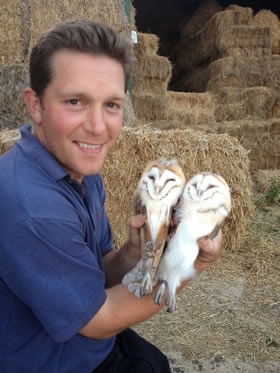 LEAF Demonstration Farmer Patrick Barker, farms a 510 hectare family owned business in partnership with his cousin, Brian. E J Barker and Sons, based at Lodge Farm, Westhope in North Suffolk, grows high quality arable crops.
LEAF Demonstration Farmer Patrick Barker, farms a 510 hectare family owned business in partnership with his cousin, Brian. E J Barker and Sons, based at Lodge Farm, Westhope in North Suffolk, grows high quality arable crops.
Ahead of the Big Farmland Bird Count next week, Patrick highlights the inseparable link between farming practices and thriving bird populations …
In 1992, set-aside was introduced to farms to reduce production and food surpluses across Europe and left in 2008 as a valuable resource for farmland wildlife, providing a food source through hard winters.
The accidental benefit to farmland wildlife was unexpected but very welcome at a time when the populations of farmland wildlife were at an all-time low.
With this in mind, I visited a farm of which we are tenants, belonging to the Suffolk Wildlife Trust at Norton in Suffolk. We farm the land, the Trust manage the Higher Level Stewardship options with their team of volunteers, the Blackbourne U3A monitor everything that moves or grows and the public enjoy a farm full of wildlife.
Between Storms Gertrude and Henry I found some rare, dry and calm weather to walk the 36ha farm to do my Big Farmland Bird Count and to check the progress of our cover crops.
Our farming strategy has changed dramatically in the past 12 months with the purchase of two brand new Sumo drills for direct (no tillage) crop establishment which effectively means the retirement of the plough, power-harrow and combination drill.
The caveat to this system is the establishment of cover crops, sown to give some TLC to our most important ally, the soil. Kings Structure Mix will increase the organic matter of the soil, build fertility and aid crop development in the following years.
This crop provided the barley stubble with a knee high covering of oil and tillage radish, oats, rye and phacelia and I was taken aback by the sheer number of birds in that single field. Snipe (80), Skylarks (300) and Meadow Pipit (200) seemed to lift out at every step with plenty of Yellowhammer, Linnet, Reed Bunting and Brown Hares seen and heard as well.
Over 100 Red-Legged Partridges and 80 Pheasant seemed to prefer this to the commercial shoot next door. In stark contrast the next two fields, an HLS over-winter stubble and a winter wheat crop, were silent in comparison. Cover crops are not there as a conservation measure, over ground at least, but we may have just found our generation’s accidental benefit to farmland wildlife.
As the afternoon drew in, a Barn Owl floated by hunting a grass margin. In Suffolk, Barn Owl numbers have increased from 100 pairs to over 400 in 20 years thanks to better grassland management and the installation of nest boxes.
I couldn’t help but wonder what the effect of expiring Environmental Stewardship schemes and the potential loss of grass margins and field corners will have. It just goes to show how reliant our wildlife is on farm land and the ways in which we manage it, whether deliberate or accidental.
The third #BFBC takes place between 6th and 14th February 2016
We're asking people to spend 30 minutes on any one day between the 6th and 14th February recording the species and number of birds seen on one particular area of the farm.
Take part in the Big Farmland Bird Count >